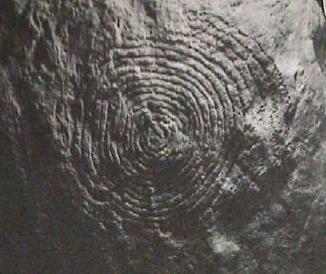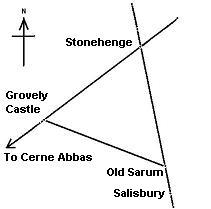|
 The Megalithic Yard:
(Prehistoric Maths)
The Megalithic Yard:
(Prehistoric Maths)
The survey carried out by Prof. Alexander Thom of over 300
European megalithic sites led him to conclude that the builders had used standard units of measurement which, along with a highly developed
knowledge of geometry, (including Pythagorean principles), were used in the design
of many of western Europe's most significant pre-historic constructions.
(
1 MY = 2.72 ft or 82.96 cm )
As Professor Thom observed in his book
Megalithic Sites in Britain (1967):
�It
is remarkable that one thousand years before the earliest mathematicians
of classical Greece, people in these islands not only had a practical
knowledge of geometry and were capable of setting out elaborate
geometrical designs but could also set out ellipses based on the
Pythagorean triangles.�
|
Prof. Alexander Thom (1894-1985): |
Alexander Thom was born in Scotland in 1894. He became a Professor
of engineering at Oxford university, and held the position for over
fifteen years from 1945 till he retired in 1961. He died in 1985.
Thom
believed that stone circles were astronomical observatories and
in 1951 he published an article in the Journal of the British
Astronomical Association entitled. 'The Solar Observations
of Megalithic Man'.
Thom initially undertook a
statistical analysis of 46 stone circles and by plotting his
measurements on a graph, he noted that many of the diameters of the
stone circles came clumped together in groups, there were several
examples with close to 22 foot (6.7 m) diameters, another group
measuring c. 44 feet (13.4 m) across and another measuring c. 55 feet
(16.8 m). A best fit for these results implied a common factor of 5.43
feet (1.65 m) which he believed could have served as a manageable unit
for measuring out figures on the ground. In 1955, following this
study, he published an article of his findings in the Journal of the
Royal Statistical Society
entitled:
'A Statistical Examination of Megalithic Sites in Britain'.
(Thom went on to survey more than 300
sites, becoming increasingly convinced of the yard's existence).
Analytical methods employed by the British
statisticians S.R. Broadbent and D.G. Kendall indicate that
the 1955 dataset has a 1% significance meaning that such a best fit
would only occur in 1 in 100 random datasets. Other archaeo-statisticians
consider Thom's original 5.43 feet, the so-called megalithic
fathom to provide a more persuasive argument for a standard
prehistoric measurement unit.
Books by Thom:
Megalithic Sites
in Britain.
Oxford Press. 1967.
Megalithic Lunar
Observatories.
Oxford Press. 1971.
Megalithic Remains
in Britain and Brittany.
Oxford Press. 1978.

Thom also concluded that
certain
spirals had been drawn with a
constant measurement which he termed the 'megalithic inch'.
|
The Origin of the Megalithic Yard: |
The origin for this standard unit of
measurement has been suggested by Knight & Lomas (1), to be a product of the
following procedure:-
There are 366 sunrises per orbit of the sun,
therefore one 366th part of the horizon = 1 megalithic degree.
First place two posts at 1 degree apart on the horizon (They do not explain
how this is done). Then swing a pendulum so that it beats 366 times in the time
it takes a star to travel between the posts (This is a very specific
request, which would require a metronome). The length of line required
for the pendulum will be 16.32 inches in length = half a megalithic yard.
(1)
Click here for a criticism of this theory...
http://www.astunit.com/astrocrud/uriel.htm
Criticisms of their calculations still produce a result that is accurate to
within a couple of millimetres. i.e. a line of 16.19" compared with Lomas'
and knight's 16.32" - (A difference of only 0.13")
Follow this link to calculate this
prehistoric measurement unit for yourself:
http://www.robertlomas.com/megyard/index.html
In a follow-up to this theory
(2), it was argued that
megalithic geometry was based on a 366˚ circle rather than the 360˚
circle that we use today. With each degree divided into 60 arc
minutes, and each minute into 6 arc seconds, which would have resulted
in each arc second having been equal to 366 Megalithic yards. If this theory is correct,
the Megalithic yard would have been a perfect subdivision of the
Earth's polar circumference: 40,008,000/(366x60x6x366)=0.8296 metres.
The idea of an ancient 366˚
division of the heavens has been suggested before, and may be gathering weight. In
principle it is a reasonable suggestion, but evidence is suggesting that
time was also measured according to the 'Metonic cycle' a combined solar and
lunar cycle with a variation of only 2 hours over 19 solar years (or 235 lunations). In addition, there is also plenty of evidence that a
division of 360˚ was used for the geodetic
placement and internal geometry of the megaliths.
(More
about Ancient Geodesy)
Robin Heath (3), suggested
that the Megalithic yard was linked to the Metonic cycle, (in which the
earth orbits the sun 18.6 times while the moon has 235 lunation's). He
proposed that if the measurement of time is transferred to the
measurement of space (i.e. each day = one Megalithic Inch 'MI'), then
the difference between the solar and lunar cycles over a three year
solar period amount to a deficit of 1.104812 lunation's, which amounts
to 32.625 days: which if transferred into Megalithic Inches 'MI' (one MI
= one solar day), equals 2.7188 ft. A figure extremely close to
Thom's estimate of 2.72 ft.
(More
about Archaeoastronomy)
It has also been reasonably argued
that as the results attained by Thom were merely averages,
and that many circles show a slight variation on this measurement, (one that even Thom himself was at odds to explain), it is possible
that the radius of circles and other prominent sites was simply
determined by pacing rather than with a string and stakes as suggested
by Thom. The length of the Megalithic Yard falls close to the average
pace of an adult male (at 0.7m).
|
Examples of the Megalithic Yard: |
Stonehenge:
The Sarsen stones at Stonehenge are 2.5 MY wide, a length that is also known
as a Megalithic Rod 'MR' The perimeter length of the sarsen ring measured
120 MY, and since the circle consists of 30 stones, the average stone
spacing is 4 MY.

(More about Stonehenge)
Avebury:
Of great interest is the fact that the distance between the stone-centres at
Avebury is 11.04m, a measurement which appears to conform especially to the
stones of the inner circles. This measure however, does not fit with the
theory of the Megalithic yard, amounting to 13.3 MY or 5.3 MR
(4), which suggests that there may
have been other factors influencing the placement of these stones.
It is noticeable that although the
Megalithic yard was not used for the seperation of the stones at Avebury,
the geometric design (below) was discovered
by Prof. Thom to have been used as the ground-plan of the site, (along
with many other European
'Type I' and 'Type II' flattened
stone circles).

(Note: Both type I and II circles possess
the Vesica-Pisces and 3:4:5 triangles)
(More about Avebury)
Carnac: "Thom and Thom
(1978) make two significant claims with regard to the Carnac
alignments: firstly that both the alignments themselves and the
stone circles were laid out according to a precise geometry, with
a standard unit of measurement (the �Megalithic Yard�), and
secondly that the alignments form part of an extrapolation device
for predicting eclipses, linked to a �lunar observatory� centred
on the Grand Menhir Bris�e at Lochmariaquer.
(More
about Carnac)
Estimates of the sizes of the
stones of the original structure at Le Grand Menhir Bris� suggest
the use of the MY in its construction.
(Le Grand Menhir and the
Megalithic yard)
As
long ago as the 1880s, Flinders Petrie, who accurately
surveyed Stonehenge, stated that the inside diameter of the
sarsen circle was intended to be 100 Roman feet or 97.318ft.
This is within one twentieth of an inch of its absolute value
of 97.32096ft.
 The Megalithic yard (32.4
inches) is virtually duplicated in the ancient Vara of
Iberia (Iberia meaning 'Hebrews'), which was the former name
for Spain and in the Gaz measurement of Northern India.
There is a substantial amount of
evidence suggesting that prehistoric people were aware of
geometry. The first recorded evidence of geometry came from
Sir. N. Lockyer, who noticed that Stonehenge was geometrically
aligned with both Grovely Castle and Old Sarum.
The Megalithic yard (32.4
inches) is virtually duplicated in the ancient Vara of
Iberia (Iberia meaning 'Hebrews'), which was the former name
for Spain and in the Gaz measurement of Northern India.
There is a substantial amount of
evidence suggesting that prehistoric people were aware of
geometry. The first recorded evidence of geometry came from
Sir. N. Lockyer, who noticed that Stonehenge was geometrically
aligned with both Grovely Castle and Old Sarum.
(Other Geometric alignments)
(Stone Circles and Measuring
Wheels: An Article By Michael Spender)
(Sacred
Geometry).
(The World-Grid).
(Archaeoastronomy).
(Prehistoric
Geodesy).
|


